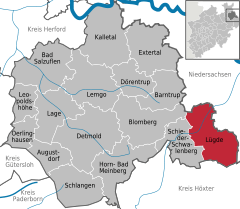Lügde
| Lügde | ||
|---|---|---|
| ||
 Lügde | ||
Location of Lügde within Lippe district 
 | ||
| Coordinates: 51°57′00″N 09°15′00″E / 51.95000°N 9.25000°ECoordinates: 51°57′00″N 09°15′00″E / 51.95000°N 9.25000°E | ||
| Country | Germany | |
| State | North Rhine-Westphalia | |
| Admin. region | Detmold | |
| District | Lippe | |
| Government | ||
| • Mayor | Heinrich Josef Reker (non-party) | |
| Area | ||
| • Total | 88.64 km2 (34.22 sq mi) | |
| Population (2015-12-31)[1] | ||
| • Total | 9,751 | |
| • Density | 110/km2 (280/sq mi) | |
| Time zone | CET/CEST (UTC+1/+2) | |
| Postal codes | 32668–32676 | |
| Dialling codes | 05281, 05283 | |
| Vehicle registration | LIP | |
| Website | www.luegde.de | |
Lügde [ˈlʏçtʰə] is a town in the Lippe district of North Rhine-Westphalia, Germany, with c. 9,800 inhabitants (2013).
The first written issue of Lügde appears in 784, in the annals of the Frankish Empire, when Charlemagne visited the village during the Saxon Wars. During this wars Charlemagne celebrated his first Christmas in Saxony in Lügde, and the site then became the location of the first church to be built in Saxony. The gothic church was rebuilt in the 12th century and it is still standing today. The church is known as the Kirche St. Kilian.
References
- ↑ "Amtliche Bevölkerungszahlen". Landesbetrieb Information und Technik NRW (in German). 18 July 2016.
External links
- Official website (German)
- Lügde News (German)
- Pumped-storage hydroelectric power plants in natural resources (German)
- Natural FFH resources (Schieder-Schwalenberger Wald) in danger (German)
This article is issued from Wikipedia - version of the 11/23/2016. The text is available under the Creative Commons Attribution/Share Alike but additional terms may apply for the media files.
